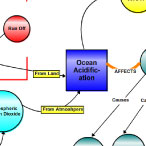|
|
Click Images to Enlarge
|
||||||||
Click Buttons for Presentation Videos & Maps |
About this Workshop:
For this workshop, 12 informal educators from the New England area (including the Seacoast Science Center and New England Aquarium) were matched with ocean and climate scientists from the University of New Hampshire to improve their collective understanding of Earth's climate and ocean systems. [more]
About this Scientist:
Joe Salisbury works on carbon cycling in the coastal ocean. His main interest regards how biological processes and land-ocean interactions affect carbon cycling in coastal waters. He is also interested in ocean acidification, and uses remote sensing data to try to understand these processes.
Joe is presently working on two strands of research. The first seeks to characterize distributions of carbon dioxide, air-sea carbon exchange and productivity in riverine-influenced coastal regions. The second involves the use of data from a variety of space-borne sensors to identify and classify estuarine and river plumes of the world.
Joe is also interested in developing more advanced plume detection methodologies in order to efficiently study the biogeochemical dynamics of plumes at broad spatial scales. CCTI projects that show promise involve the coupling of physical flow fields with ocean color data to study the trajectory and persistence of surface plumes, and the use of MODIS fluorescence data to help segregate river-derived constituents from biomass produced in-situ. [more]













